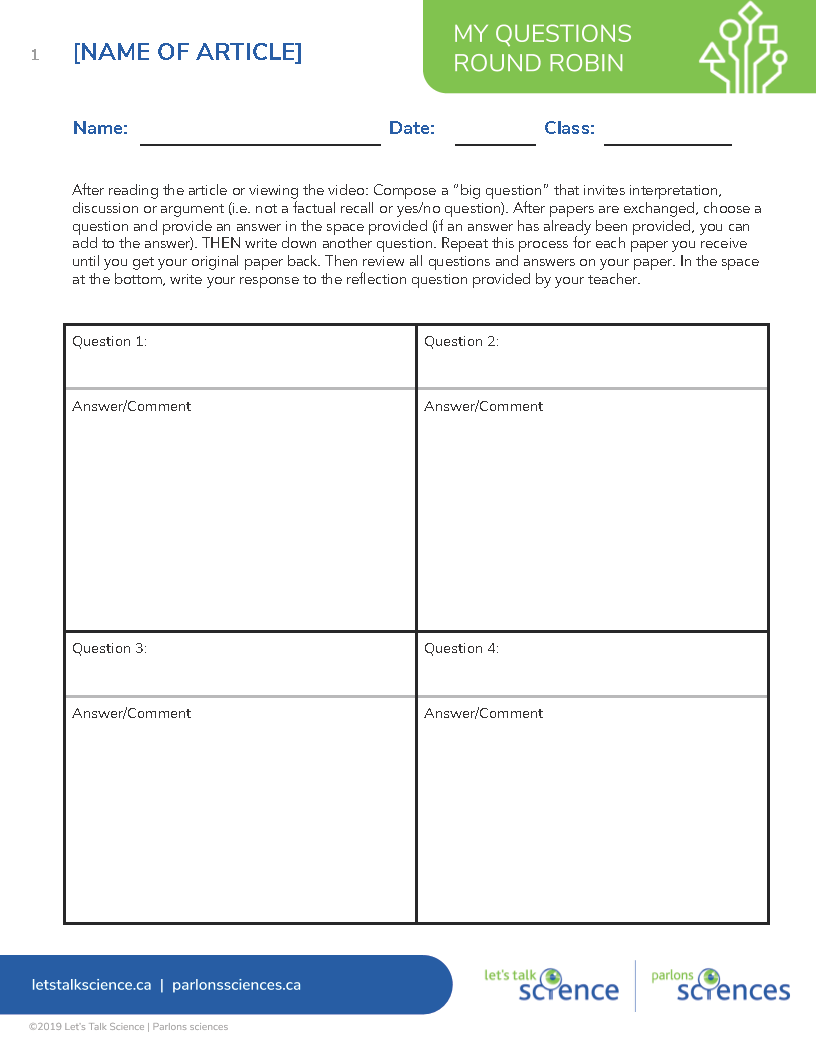My Questions Round Robin

A student passing a paper (twinsterphoto, iStockphoto)

A student passing a paper (twinsterphoto, iStockphoto)
How does this align with my curriculum?
PE
5
Integrated Curriculum Grade 5: Science (Draft 2023)
IS 1.4: Collaborating with others effectively can help us to share meaningful explorations in impactful ways.
PE
6
Integrated Curriculum Grade 6: Science (Draft 2023)
IS 1.4: Collaborating with others effectively can help us to share meaningful explorations in impactful ways.
PE
6
Integrated Curriculum Grade 6: Science (Draft 2023)
IS 1.4: Effectively communicate the results of their inquiry.
This strategy helps students develop and refine meaningful questions about content.
Why use it?
- To provide students with the opportunity to ask personally meaningful questions of content.
- To provide students with the opportunity to develop skills related to asking divergent or open-ended questions.
- To provide students with the opportunity to hear the perspectives of others on a common topic.
- To provide students with the opportunity to practice the skills of communication, collaboration, and critical thinking.
- To activate students’ prior knowledge on a topic to be discussed in class.
Tips for success
- Review with students the different types of questions (open vs closed, divergent vs convergent) and the types of cognitive skills (e.g., Bloom’s taxonomy) that are required to develop various questions and prompts. A “Q-chart” or “Question Matrix” could be used to assist students in developing higher order questions.
- Review expectations for positive interactions that value each person’s input and refrain from destructive criticism of ideas and questions put forth.
- If necessary, stimulate students’ recall of the topics by reminding them of related content or polling students on different aspects of the topic.
- Allow sufficient thinking time before students begin to write. Ensure students understand that some students require more processing time and that they may not get to write as much as others who do not.
- A student with written output difficulties could use an audio recording device which would be passed to the next person in the group.
How do I use it?
- After students have read the article or viewed the video, organize the students in groups of 3 to 4. Provide each student with a blank My Questions Round Robin Template.

- Students are to create a question about the content they have just viewed, read or discussed (Questions 1). Questions are to be “big questions”: divergent and open-ended, not closed-ended factual recall questions. Students should avoid questions that start with “what”, “where”, or “when” as these tend to be factual in nature.
- After students have composed their questions (2-3 minutes), signal students to pass their papers to the student on their right.
- Upon the “start” signal, each student will read the question and provide an answer. If the question is closed/factual, it can be rewritten before an answer is provided.
- After they write their answers, students are to each write a new question in the space provided (question 2).
- After 2 – 3 minutes, signal for the papers to be passed (“PASS”) and the papers are again passed to the student on the right. Students can either answer the new question or add to the answer provided for the previous question. They then write a new question in the space provided (question 3). This process continues until each student eventually gets his/her original paper back.
- When students receive their original papers they are to read the questions, comments and answers provided. Then they are to answer the reflection question provided. Some possible reflection questions are:
- What did you learn from the process of generating questions?
- What have you learned about the topic so far?
- What did you learn from the questions, comments or answers provided by your group members?
- What challenges did you encounter while doing this activity?
- Which question or answer do you think is the most noteworthy? Why?
Variations
- Organize students in pairs to develop their questions. Exchange questions with another pair of students. Bring pairs together as quads to discuss their responses and to select one question to present to the class.
- Instead of providing an answer to the question, students could rework the question to change it from open to closed or vice versa or write comments that ask for clarification or provide suggestions on how to improve the question.
- Have students use software such as Google docs to write their questions or compose questions on a laptop or tablet which is passed to the person on the right.
Extensions
- Provide students with a list of action verbs based on Bloom’s taxonomy. Assign specific levels of Bloom’s taxonomy for students to compose appropriate questions.
Assessment
- Collect each student’s My Questions Round Robin sheet for review.
Using this Strategy
My Questions Round Robin Reproducible Template [Google doc] [.pdf]
- How are the World's Bee Populations Doing?: My Questions Round Robin Reproducible [Google Doc] [PDF]
-
The Science Behind Calories and Nutrition Facts Labels - My Questions Round Robin Reproducible [Google Doc] [PDF]
- The Wacky History of Cell Theory: My Questions Round Robin Reproducible [Google Doc] [PDF]
- What are the Pros and Cons of Nuclear Energy?: My Questions Round Robin Reproducible [Google Doc] [PDF]
Create Your Own
My Questions Round Robin Reproducible Template [Google doc] [.pdf]
Ready to Use
- How are the World's Bee Populations Doing?: My Questions Round Robin Reproducible [Google Doc] [PDF]
-
The Science Behind Calories and Nutrition Facts Labels - My Questions Round Robin Reproducible [Google Doc] [PDF]
- The Wacky History of Cell Theory: My Questions Round Robin Reproducible [Google Doc] [PDF]
- What are the Pros and Cons of Nuclear Energy?: My Questions Round Robin Reproducible [Google Doc] [PDF]
References
Ontario Ministry of Education (2012). Adolescent literacy guide: A professional learning resource for literacy, grade 7-12.
Daniels H., Zemelman, S., Steineke, N. (2007). Content-area writing: Every teacher's guide. Heinemann.